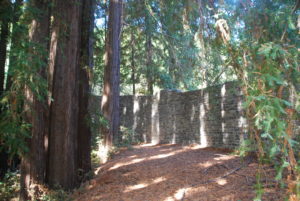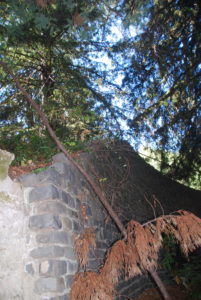
In a town that was as much about stasis ("We're going to be immortal!") as about change (if a business wasn't profitable, it was closed), there are still a couple of things that have outlived both William and Lucille Riker and the ravages of time and human misbehavior.
One is the Riker home, which is still lived in. The other is the circle of redwoods once known as the Temple of the Gods. And if you were to walk into the grove and look up, you'd see another feature that seems impervious to time.
Today, the Old Santa Cruz Highway runs past the grove. However, most of the commuters who speed by are oblivious to what happened there, primarily because the trees are protected by a wall of cut stones about the size of bricks, laid a couple of feet thick and some twelve feet high.
There are two stories about the source of these stones. According to the first, they were made by inmates of San Quentin Prison and trucked to Holy City (bringing to mind the old bluegrass tune, "In the Gravel Yard"). According to the second story, they were ballast from a ship sunk in the San Francisco harbor. Between the Gold Rush years and the earthquake of 1906, ships were sometimes sunk on purpose, or for that matter, repurposed, to extend the waterfront. I have no proof of either theory about the stones, but I wonder if their purpose at Holy City was less protection from land movement than protection from prying eyes.

The wall does not extend all the way around the grove; its U-shape only protects the public side. The side facing the town is wide open. The arc gives the effect of a broken or half-constructed apse ... made of stones chipped into shape by other criminals and con men, if the San Quentin story is true. In this natural church, there was no altar then, but instead only the stage on which the Comforter performed. Today, the stage is gone and there is only a homemade ofrenda, with pictures of loved ones and other religious icons left by people over the years.
The wall still protects the quiet grove from what critic Leo Marx calls the “shocking intruder” of the highway and all its traffic (The Machine in the Garden: Technology and the Pastoral Ideal in America, p. 29). The wall excludes people on the one side, but at the same time it invites them in from the other.
Perhaps both the wall and Holy City were at once exclusive and inclusive, depending on the direction from which the curious approached.
SAB, October 25, 2019